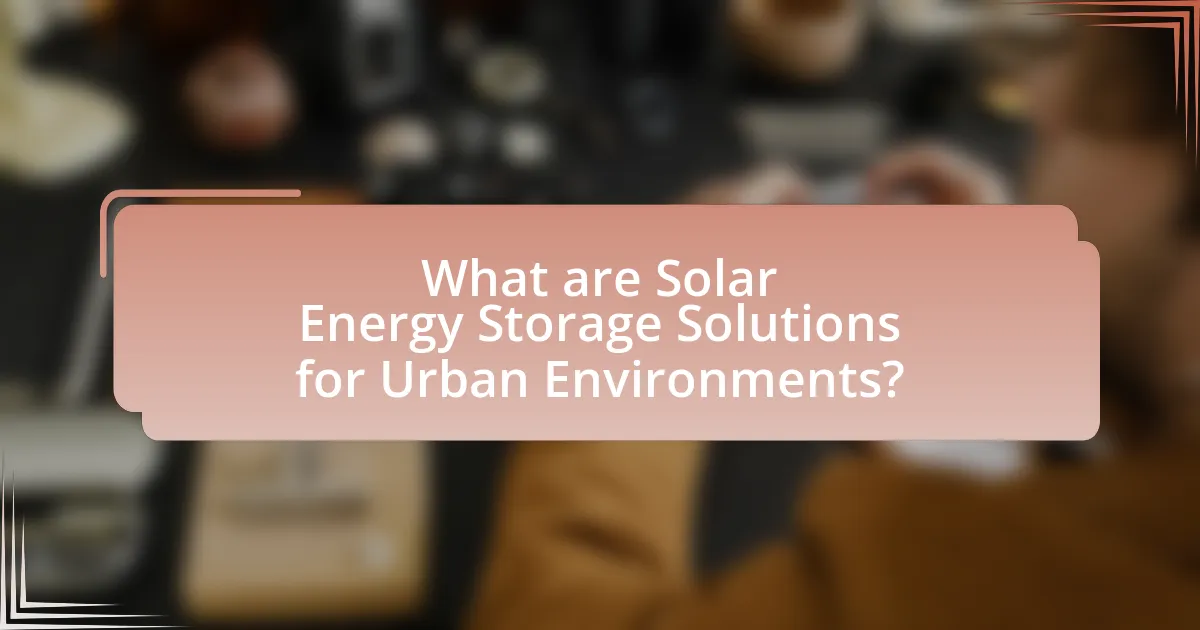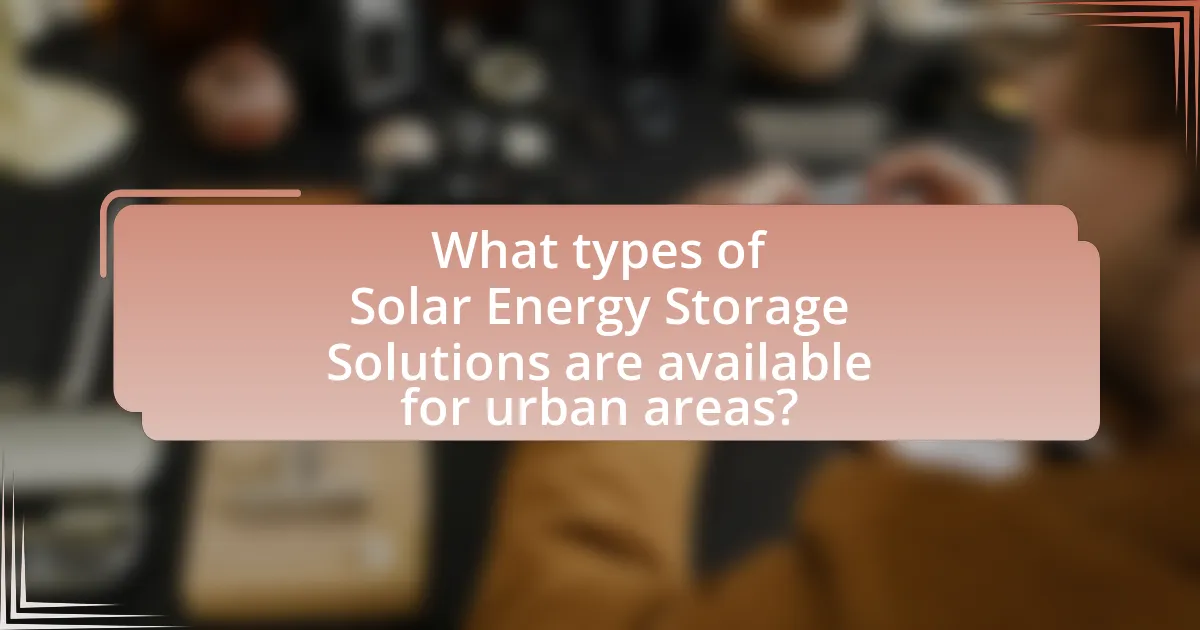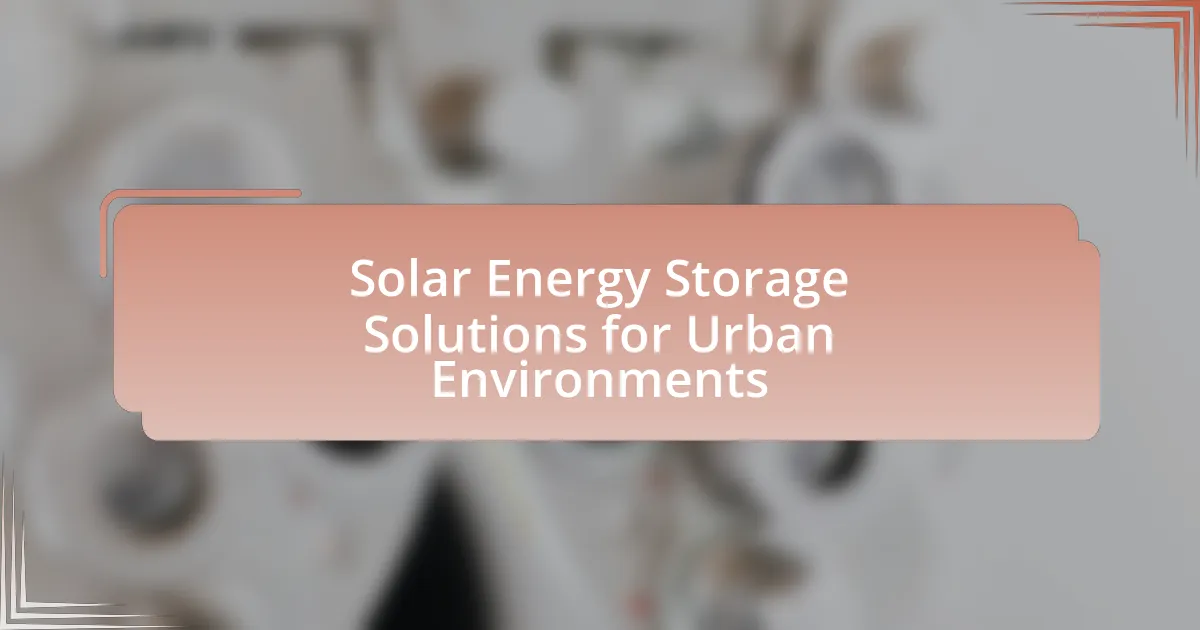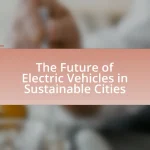Solar energy storage solutions for urban environments encompass various technologies, including battery storage systems, thermal energy storage, and grid-integrated solutions. These systems capture excess solar energy generated during peak sunlight hours for later use, enhancing energy reliability and reducing dependence on fossil fuels. Key technologies such as lithium-ion and flow batteries, along with thermal storage methods, play a crucial role in optimizing energy consumption and supporting sustainability in cities. The article explores the functionality, advantages, challenges, and future trends of these solutions, emphasizing their importance in urban energy management and resilience.

What are Solar Energy Storage Solutions for Urban Environments?
Solar energy storage solutions for urban environments include battery storage systems, thermal energy storage, and grid-integrated solutions. Battery storage systems, such as lithium-ion batteries, allow for the capture and storage of solar energy generated during the day for use during peak demand times or at night. Thermal energy storage systems, like molten salt or ice storage, store excess solar heat for later use in heating or cooling buildings. Grid-integrated solutions, such as virtual power plants, enable multiple solar energy systems to work together, optimizing energy distribution and storage across urban areas. These solutions are essential for enhancing energy resilience, reducing reliance on fossil fuels, and supporting the transition to sustainable urban energy systems.
How do Solar Energy Storage Solutions function in urban settings?
Solar energy storage solutions in urban settings function by capturing excess energy generated from solar panels during peak sunlight hours and storing it for later use, particularly during periods of low sunlight or high demand. These systems typically utilize batteries, such as lithium-ion or flow batteries, which can efficiently store energy and release it when needed, thereby enhancing energy reliability and reducing dependence on the grid. In urban environments, where space is limited, these storage solutions are often integrated into existing infrastructure, such as rooftops or building energy management systems, allowing for optimized energy use and improved sustainability. According to the U.S. Department of Energy, energy storage can increase the efficiency of solar energy systems by up to 30%, making them a vital component in urban energy strategies.
What technologies are involved in Solar Energy Storage Solutions?
Solar energy storage solutions involve several key technologies, including lithium-ion batteries, flow batteries, and thermal energy storage systems. Lithium-ion batteries are widely used due to their high energy density and efficiency, making them suitable for residential and commercial applications. Flow batteries, which utilize liquid electrolytes, offer scalability and longer discharge times, ideal for larger energy storage needs. Thermal energy storage systems, such as molten salt or ice storage, capture excess solar energy for later use, providing a reliable energy supply during peak demand periods. These technologies collectively enhance the efficiency and reliability of solar energy systems in urban environments.
How do these technologies integrate with urban infrastructure?
Solar energy storage technologies integrate with urban infrastructure by providing a reliable means to store excess solar energy generated during the day for use during peak demand times or at night. These systems, such as lithium-ion batteries and flow batteries, can be installed in residential, commercial, and municipal buildings, allowing for energy independence and reduced reliance on the grid. For instance, cities like San Diego have implemented solar storage solutions that enable homes to store solar energy, which can then be used to power appliances during high-demand periods, effectively balancing energy loads and enhancing grid stability. This integration not only promotes sustainability but also contributes to energy resilience in urban environments, as evidenced by the increasing adoption of solar-plus-storage systems in urban planning initiatives across various cities.
Why are Solar Energy Storage Solutions important for cities?
Solar energy storage solutions are important for cities because they enable the effective use of renewable energy, enhance grid stability, and reduce reliance on fossil fuels. By storing excess solar energy generated during the day, cities can ensure a continuous power supply during peak demand times or when solar generation is low, thus improving energy resilience. According to the U.S. Department of Energy, energy storage can help integrate up to 30% of solar energy into the grid without compromising reliability. This capability not only supports sustainability goals but also contributes to lower energy costs and reduced greenhouse gas emissions, making cities more environmentally friendly and economically viable.
What challenges do urban environments face regarding energy storage?
Urban environments face significant challenges regarding energy storage, primarily due to space constraints, high population density, and infrastructure limitations. Space constraints limit the installation of large-scale energy storage systems, as urban areas often have limited available land. High population density increases energy demand, necessitating efficient storage solutions to manage peak loads and ensure reliability. Additionally, existing infrastructure may not support advanced energy storage technologies, complicating integration with renewable energy sources like solar. These factors collectively hinder the effective implementation of energy storage solutions in urban settings.
How do these solutions contribute to sustainability in cities?
Solar energy storage solutions contribute to sustainability in cities by enabling the efficient use of renewable energy, reducing reliance on fossil fuels, and minimizing greenhouse gas emissions. These systems store excess solar energy generated during the day for use during peak demand times or at night, thereby optimizing energy consumption and enhancing grid stability. For instance, studies show that integrating solar energy storage can lead to a reduction in carbon emissions by up to 80% in urban areas, as it allows for a greater share of renewable energy in the energy mix. Additionally, these solutions can lower energy costs for consumers and improve energy resilience, making cities more sustainable in the long term.

What types of Solar Energy Storage Solutions are available for urban areas?
The types of solar energy storage solutions available for urban areas include lithium-ion batteries, flow batteries, and thermal energy storage systems. Lithium-ion batteries are widely used due to their high energy density and efficiency, making them suitable for residential and commercial applications. Flow batteries offer scalability and longer discharge times, which can be beneficial for larger installations. Thermal energy storage systems, such as molten salt or ice storage, allow for the storage of excess solar energy in the form of heat, which can be used for heating or converted back to electricity when needed. These solutions are increasingly adopted in urban settings to enhance energy resilience and support renewable energy integration.
What are the most common types of solar energy storage systems?
The most common types of solar energy storage systems are lithium-ion batteries, lead-acid batteries, and flow batteries. Lithium-ion batteries are widely used due to their high energy density and efficiency, making them suitable for residential and commercial applications. Lead-acid batteries, while older technology, are still prevalent due to their lower initial cost and reliability for off-grid systems. Flow batteries, although less common, offer advantages in scalability and longer discharge times, making them suitable for larger energy storage needs. These systems are essential for optimizing solar energy use, enabling energy storage for later use, and enhancing grid stability.
How do battery storage systems work in urban environments?
Battery storage systems in urban environments function by storing excess energy generated from renewable sources, such as solar panels, for later use. These systems capture energy during peak production times, typically when sunlight is abundant, and release it during periods of high demand or low production, thereby enhancing energy reliability and efficiency.
In urban settings, where space is limited, battery storage systems are often integrated into buildings or community energy systems, allowing for localized energy management. This integration supports grid stability and reduces reliance on fossil fuels, contributing to lower greenhouse gas emissions. According to the U.S. Department of Energy, energy storage can help balance supply and demand, with studies indicating that battery storage can reduce peak demand by up to 30%.
What role do thermal storage systems play in urban energy management?
Thermal storage systems play a crucial role in urban energy management by enabling the efficient use of energy generated from renewable sources, particularly solar energy. These systems store excess thermal energy produced during peak sunlight hours and release it during periods of high demand or low generation, thus balancing supply and demand. For instance, a study by the International Energy Agency highlights that integrating thermal storage can reduce energy costs and enhance grid stability by shifting energy consumption patterns. This capability is essential in urban environments where energy demand fluctuates significantly throughout the day.
What are the advantages and disadvantages of different storage solutions?
Different storage solutions for solar energy in urban environments include lithium-ion batteries, pumped hydro storage, and thermal storage, each with distinct advantages and disadvantages. Lithium-ion batteries offer high energy density and rapid response times, making them suitable for residential applications; however, they have a limited lifespan and environmental concerns related to mining and disposal. Pumped hydro storage provides large-scale energy storage with long discharge durations and low operational costs, but it requires significant geographical constraints and can impact local ecosystems. Thermal storage systems, such as molten salt, can store energy for extended periods and are efficient for concentrated solar power plants, yet they involve high initial costs and complex infrastructure. These characteristics highlight the trade-offs between efficiency, cost, environmental impact, and scalability in selecting appropriate storage solutions for solar energy in urban settings.
How do costs compare among various solar energy storage options?
Costs for solar energy storage options vary significantly, with lithium-ion batteries typically ranging from $400 to $700 per kilowatt-hour, while lead-acid batteries are generally cheaper at about $150 to $300 per kilowatt-hour. Flow batteries, another option, can cost between $500 and $1,000 per kilowatt-hour. The higher initial investment in lithium-ion batteries is often justified by their longer lifespan and higher efficiency, which can lead to lower overall costs over time. According to the U.S. Department of Energy, lithium-ion batteries have a cycle life of around 2,000 to 5,000 cycles, compared to lead-acid batteries, which last about 500 to 1,500 cycles. This durability and performance make lithium-ion a preferred choice despite the higher upfront costs.
What are the maintenance requirements for these systems?
The maintenance requirements for solar energy storage systems in urban environments include regular inspections, cleaning of solar panels, battery management, and software updates. Regular inspections ensure that all components are functioning correctly and safely, while cleaning solar panels maximizes energy absorption by removing dirt and debris. Battery management involves monitoring charge cycles and health to prolong battery life, and software updates are necessary to enhance system performance and security. These practices are essential for maintaining efficiency and reliability, as studies indicate that proper maintenance can increase the lifespan of solar energy systems by up to 25%.

How can cities effectively implement Solar Energy Storage Solutions?
Cities can effectively implement solar energy storage solutions by integrating advanced battery systems with existing solar infrastructure. This integration allows for the capture and storage of excess solar energy generated during peak sunlight hours, which can then be utilized during periods of high demand or low solar generation. For instance, cities can deploy lithium-ion batteries, which have shown a capacity to store energy efficiently, as evidenced by a report from the National Renewable Energy Laboratory indicating that battery storage can enhance grid reliability and reduce energy costs. Additionally, cities can incentivize the installation of solar-plus-storage systems through subsidies and grants, promoting wider adoption among residential and commercial users. This approach not only maximizes the use of renewable energy but also contributes to energy resilience and sustainability in urban environments.
What strategies can urban planners use to promote solar energy storage?
Urban planners can promote solar energy storage by implementing policies that incentivize the installation of solar storage systems, such as tax credits and rebates. These financial incentives encourage homeowners and businesses to invest in solar energy storage, making it more accessible. Additionally, urban planners can integrate solar energy storage into zoning regulations, allowing for the development of solar-ready buildings and communities. Research indicates that cities with supportive policies see a higher adoption rate of solar technologies; for instance, California’s Self-Generation Incentive Program has led to significant increases in energy storage installations. Furthermore, planners can facilitate community solar projects that include storage solutions, enabling shared access to solar energy and storage benefits for residents who may not have suitable rooftops for solar panels.
How can policy changes facilitate the adoption of these solutions?
Policy changes can facilitate the adoption of solar energy storage solutions for urban environments by providing financial incentives, regulatory support, and infrastructure development. Financial incentives, such as tax credits and rebates, lower the initial investment barrier for consumers and businesses, encouraging them to adopt solar storage technologies. Regulatory support, including streamlined permitting processes and interconnection standards, simplifies the integration of these solutions into existing energy systems. Additionally, policies that promote research and development can lead to technological advancements, making solar energy storage more efficient and cost-effective. For instance, the U.S. federal Investment Tax Credit has significantly boosted solar installations, demonstrating how targeted policy can drive adoption.
What role do public-private partnerships play in implementation?
Public-private partnerships (PPPs) play a crucial role in the implementation of solar energy storage solutions for urban environments by facilitating collaboration between government entities and private sector companies. These partnerships leverage the strengths of both sectors, where public entities provide regulatory support and funding, while private companies contribute technological expertise and innovation. For instance, a study by the International Renewable Energy Agency (IRENA) highlights that PPPs can accelerate project development timelines and reduce costs through shared resources and risk management. This collaborative approach has been instrumental in deploying solar energy storage systems, as evidenced by successful projects in cities like San Diego, where partnerships have led to significant advancements in energy resilience and sustainability.
What are best practices for integrating solar energy storage in urban environments?
Best practices for integrating solar energy storage in urban environments include optimizing system design for space efficiency, utilizing advanced battery technologies, and implementing smart grid solutions. Urban areas often face space constraints, so compact solar energy storage systems, such as lithium-ion batteries, are essential for maximizing energy capture and storage. According to the U.S. Department of Energy, lithium-ion batteries have a high energy density, making them suitable for urban settings where space is limited. Additionally, integrating smart grid technologies allows for real-time energy management, enhancing the efficiency of solar energy use and storage. Research from the National Renewable Energy Laboratory indicates that smart grid integration can improve energy distribution and reduce costs by up to 30%. Furthermore, community solar projects can facilitate shared energy storage solutions, allowing multiple users to benefit from a single solar installation, thereby increasing accessibility and reducing individual costs.
How can cities optimize the use of solar energy storage systems?
Cities can optimize the use of solar energy storage systems by implementing smart grid technologies that enhance energy management and storage efficiency. Smart grids facilitate real-time monitoring and control of energy flow, allowing cities to balance supply and demand effectively. For instance, integrating energy storage with renewable sources can reduce peak load demands and enhance grid stability. According to the U.S. Department of Energy, energy storage systems can provide ancillary services, such as frequency regulation and voltage support, which are crucial for maintaining grid reliability. Additionally, cities can incentivize the installation of solar storage systems through subsidies or tax credits, promoting wider adoption and maximizing the benefits of solar energy.
What common pitfalls should cities avoid when implementing these solutions?
Cities should avoid inadequate planning and stakeholder engagement when implementing solar energy storage solutions. Insufficient planning can lead to mismatched energy needs and storage capacities, resulting in wasted resources and ineffective systems. For instance, a study by the National Renewable Energy Laboratory highlights that cities often fail to assess their specific energy demands, which can lead to over- or under-sizing storage systems. Additionally, neglecting to involve local communities and stakeholders can result in resistance to projects, as seen in various urban solar initiatives where public opposition delayed implementation. Engaging stakeholders ensures that solutions are tailored to community needs and fosters support for the projects.
What future trends are shaping Solar Energy Storage Solutions in urban areas?
Future trends shaping solar energy storage solutions in urban areas include advancements in battery technology, increased integration with smart grids, and the rise of decentralized energy systems. Battery technology is evolving with innovations such as solid-state batteries, which offer higher energy density and safety compared to traditional lithium-ion batteries. The integration with smart grids allows for better energy management and optimization, enabling real-time data analysis and demand response capabilities. Additionally, decentralized energy systems, including community solar projects and peer-to-peer energy trading, are gaining traction, allowing urban residents to share and store energy more efficiently. These trends are supported by the growing need for sustainable energy solutions in densely populated areas, as urban centers account for over 70% of global energy consumption.
How is technology evolving to enhance solar energy storage?
Technology is evolving to enhance solar energy storage through advancements in battery chemistry, such as lithium-sulfur and solid-state batteries, which offer higher energy densities and longer lifespans compared to traditional lithium-ion batteries. These innovations enable more efficient storage of solar energy, allowing for greater energy retention and reduced costs. For instance, lithium-sulfur batteries can theoretically achieve energy densities of up to 500 Wh/kg, significantly surpassing the 250 Wh/kg of conventional lithium-ion batteries. Additionally, the integration of artificial intelligence in energy management systems optimizes the charging and discharging cycles of storage systems, further improving efficiency and reliability.
What innovations are on the horizon for urban energy storage solutions?
Innovations on the horizon for urban energy storage solutions include advancements in solid-state batteries, which offer higher energy density and improved safety compared to traditional lithium-ion batteries. These batteries are being developed to enhance the efficiency of solar energy systems in urban settings, allowing for better integration with renewable sources. Additionally, the emergence of flow batteries is promising, as they provide scalable energy storage options that can be tailored to meet the specific demands of urban environments. Research indicates that these technologies can significantly reduce costs and increase the lifespan of energy storage systems, making them more viable for widespread adoption in cities.
What practical tips can cities follow to maximize the benefits of Solar Energy Storage Solutions?
Cities can maximize the benefits of Solar Energy Storage Solutions by implementing integrated energy management systems that optimize the use of stored solar energy. These systems can monitor energy consumption patterns and adjust the distribution of stored energy accordingly, ensuring that solar energy is utilized efficiently during peak demand times. Additionally, cities should invest in community solar projects that allow multiple users to benefit from a single solar installation, thereby increasing access to solar energy and storage solutions.
Furthermore, cities can promote policies that incentivize the installation of solar energy storage systems in residential and commercial buildings, such as tax credits or rebates. This approach not only encourages adoption but also enhances grid resilience by reducing reliance on centralized power sources. According to the U.S. Department of Energy, energy storage can provide significant benefits, including improved grid reliability and reduced energy costs, which reinforces the importance of these strategies.


